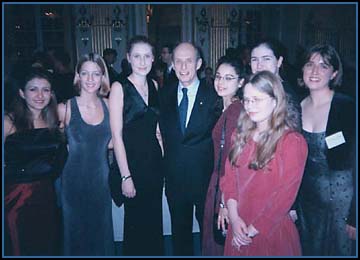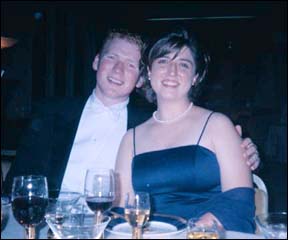 "Oh my gosh," said Torborg as she started to explain the grandeur of the Nobel Prize ceremony, and the banquet and ball that followed it. "It was incredible. You would not believe. It was like the Academy Awards."
"Oh my gosh," said Torborg as she started to explain the grandeur of the Nobel Prize ceremony, and the banquet and ball that followed it. "It was incredible. You would not believe. It was like the Academy Awards." The pageantry of the Nobel Prizes might not be as dazzling as the Academy Awards, but for academics to even rival Hollywood in pizzazz says something.
The pageantry of the Nobel Prizes might not be as dazzling as the Academy Awards, but for academics to even rival Hollywood in pizzazz says something."It struck me that the biggest party of the year is about academics," said Christine Torborg (pictured with another student at the Nobel Prize banquet) , a Paynesville native who spent ten days in Sweden in December to witness the 2000 Nobel Prizes. "Cause it is the biggest party of the year in Sweden."
Torborg, for one, should appreciate it. For the Nobel Prizes were not just an all-expenses-paid trip for her, but as a scientist it would be her ultimate goal to return as a winner.
Torborg graduated from Gustavus Aldophous College in St. Peter last May with a degree in biology and chemistry. Based on academic merit, she was chosen the Gustavus nominee for the Seaborg Travel Award from the Swedish Council of America. Then she was chosen as the winner from the six Swedish universities in the United States.
She joined a group of 25 students from around the world for the seven-day Stockholm International Youth Science Seminar for 2000. The group included students from 18 countries. Torborg spent from Dec. 4 to Dec. 13 in Sweden.
The conference is held in conjunction with the awarding of the Nobel Prizes. These were established a century ago in the will of Swedish chemist and manufacturer Alfred Nobel. They are awarded each year on Dec. 10, the date of Nobel's death.
In the first two days, the seminar took Torborg on a sight-seeing tour of Stock-holm, on a visit to Uppsala University, on guided tours of the Swedish Parliament and to the royal castle, and to an audience with The Crown Princess of Sweden.
They also attended press conferences with some of the Nobel Laureates, receptions for the winners, and lectures. Each winner is required to present a summary of their work.
Even for Torborg - who is now pursuing a doctorate in neurosciences from the University of California-San Diego - the day they heard six one-hour lectures about scientific research was long. "A lot of the stuff they talked about I didn't even understand," she said. "And I'm a chemist."
On another day, each of the student participants in the seminar also had to give a 10-minute presentation about their own research before their peers.
Receptions and balls
 "Oh my gosh," said Torborg as she started to explain the grandeur of the Nobel Prize ceremony, and the banquet and ball that followed it. "It was incredible. You would not believe. It was like the Academy Awards."
"Oh my gosh," said Torborg as she started to explain the grandeur of the Nobel Prize ceremony, and the banquet and ball that followed it. "It was incredible. You would not believe. It was like the Academy Awards."
Christine at far right with Nobel Prize winner in the center, Paul Greengard.
The event was covered by Swedish television and photographers. Like everyone else, the students arrived in limousines and walked on a red carpet up the huge stairs to the concert hall with gilded ornamentation.
The dress and etiquette were formal.
Christine's only expense for the trip, aside from souvenirs, was buying two formal gowns to wear for the official reception on Saturday, Dec. 9, and to the awards ceremony, banquet and ball on Sunday, Dec. 10.
"They had so many stipulations on what you could wear," she explained. "It couldn't be black and it couldn't be white. It had to be full length and it had to be a full skirt."
Tuxes for men had to have white ties and vests and black shoes and shoelaces. As part of the seminar, the students received etiquette and dancing training. Torborg learned high society rules like how to toast correctly and not to start to eat before the king does.
Around 1,400 people attended the awards ceremony in the concert hall, and 1,100 attended the banquet in the Stockholm City Hall. Attending were the laureates and their families, members of the Swedish Royal Family, prominent Swedish politicians and academics, and members of the diplomatic corps.
The awards ceremony started at 6 p.m., the banquet lasted three hours, and the ball lasted nearly three hours. They had a formal night cap at 5 a.m.
The day, like the trip, was exhausting and intense.
"It was the chance of a lifetime," Torborg said. "Well, actually, hopefully not. Hopefully I'll be back sometime in the future."
Torborg is in her first year of graduate work at UCSD. She hopes to finish her doctorate in five or six years, and plans to work either in research or teaching.
She enjoyed learning about Swedish culture and Swedish politics, and gaining insight into nonAmerican perspectives of the world. She also enjoyed learning about science funding a research in other countries. "One of the highlights was getting to meet people from all over the world and live with them for a week," she said.
The daughter of Roger and Sharon Torborg of Paynesville, Torborg graduated from Paynesville Area High School in 1996.
Nobel Prizes awarded since 1901
Alfred Nobel, born in 1833, made a fortune from his discovery and manufacturing explosives, and used it to fund awards for scientific research and peace.
Experimenting in his father's factory, the Swedish chemist made dynamite from a mixture of nitroglycerin and a porous powder. He patented his mixture in 1867. Relatively safe, yet powerfully explosive, dynamite was sold in large quantities to mining companies and military organizations. Nobel had factories around the world and made a fortune from the sale of explosives.
Nobel - who was born in Stockholm and educated in Russia - also did research in artificial forms of rubber, leather, silk, and stones. He wrote poetry, novels and plays as well.
The world famous Nobel Prizes were established in his will after Nobel's death in 1896. A $9 million endowment from his estate funded five annual awards, which were first presented in 1901. Nobel wanted the profits from explosive manufacturing to encourage work that benefited humanity. The awards honor the top achievements in the fields of: physics, chemistry, physiology or medicine, literature, and peace. An economics prize -started in 1969 - is awarded in Nobel's name by the Bank of Sweden.
Winners must be nominated, and committees select the winners. Up to three people can win each award. The science, literature and economic prizes are chosen and awarded in Sweden. Nobel specified that the peace prize should be selected in Norway. Winners receive a medal and share a monetary award of more than $1 million per field.
The awards are presented on Dec. 10 each year, the date of Nobel's death.
Past winners include: scientists Max Planck, Albert Einstein, Niels Bohr, Enrico Fermi, and Ivan Pavlov; writers Rudyard Kipling, T.S. Eliot, William Faulkner, Sir Winston Churchill, Ernest Hemingway, and John Steinbeck; and peacemakers Teddy Roosevelt, Martin Luther King Jr., Henry Kissinger, Menachem Begin, Anwar Sadat, and Mother Theresa.
Sinclair Lewis, born in Sauk Centre, won the Nobel Prize for literature in 1930.
Scientists Marie Curie and Linus Pauling were repeat winners. Curie shared the physics award in 1903 and won the chemistry award in 1911. Pauling won the chemistry award in 1954 and the peace award in 1962 for his efforts against nuclear weapons and for a ban on nuclear testing.
International organizations like Amnesty International, UNICEF, the International Red Cross, and the United Nations have won the peace prize.
(Information from the World Book Encyclopedia, 1994 edition.)